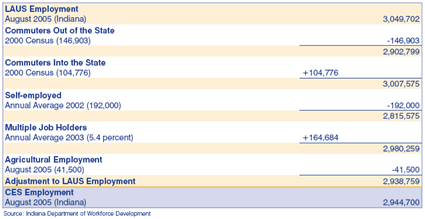Household vs. Payroll Surveys: Which is More Reliable
There are two surveys that the Indiana Department of Workforce Development uses to measure employment: the household survey and the payroll survey. The Current Population Survey (CPS) is based on household interviews conducted each month by the U.S. Census Bureau for the Bureau of Labor Statistics and provides comprehensive data on the labor force, including those who are employed and unemployed. The data are further classified by age, sex, family relationship and marital status. Fifty thousand households located in 792 sample areas, including all counties and independent cities in the country, participate in the survey. The household survey provides data that is used to calculate the Local Area Unemployment Statistics (LAUS) for regions, counties and selected cities and towns.
The Current Employment Statistics (CES) survey utilizes payroll records and is designed to provide industry information on nonfarm wage and salary employment, average weekly hours and average hourly earnings for the nation, states and metropolitan areas. The employment, hours and earnings data are based on payroll reports from a sample of over 390,000 establishments employing over 47 million nonfarm wage and salary workers, full- or part-time, who receive pay during the payroll period beginning on the 12th of each month. The payroll survey includes the number of payroll jobs in an area, no matter where those employees actually live. Industry employment is published statewide and for metropolitan statistical areas by NAICS supersectors.
The best way to distinguish between the two types of employment numbers is that LAUS data is based on residence (i.e., household) whereas CES data is based on place of work establishment taken from payroll records.
The household and payroll data complement each other in that each provides significant types of information the other cannot. Population characteristics, for example, are only obtained from the household survey, whereas detailed industrial classifications are much more reliably derived from the payroll survey. Another difference is that the household survey only distinguishes between whether a person is employed or unemployed, whereas CES counts each employee that is on an employer’s payroll. This means that a multiple jobholder can be counted several times by the CES survey, but would only be counted once by the CPS survey. In addition, CES excludes business owners, self-employed persons, unpaid volunteers and private household workers, and those on unpaid leave or not working because of a labor dispute.
According to the Economic Policy Institute, the payroll survey is the preferred method of measuring job growth by experts such as the Congressional Budget Office, the Bureau of Labor Statistics, the Council of Economic Advisors and Federal Reserve Board Chairman Alan Greenspan. While the experts agree that the payroll survey is a better measure of employment than the household survey, some continue to use the household survey, arguing that growth in entrepreneurship overwhelms the job losses recorded in the payroll survey because the latter does not include self-employment.
LAUS and CES typically produce different sets of total employment numbers. For example, in August 2005, the LAUS employment figure is estimated to be 3,049,702 whereas the CES employment figure is estimated to be 2,944,700. This difference of 105,002 can be translated into a pool of workers large enough to supply a mid-sized city in Indiana.
LAUS and CES
Table 1 attempts to reconcile the difference in total employment between LAUS and CES using commuting patterns, multiple jobholders and self-employment data.
Table 1: Reconciliation between LAUS and CES Employment Data
Census 2000 estimated that 146,903 Hoosiers commuted out of state for work. The number of out-of-state residents that commuted to Indiana for work totaled 104,776. This is a net difference of 42,127 employed people that are not included in the payroll survey, assuming that all commuters are eligible to be included in nonfarm estimates.
The annual estimate of self-employed by CPS was about 192,000 for 2000. The number of multiple jobholders as estimated by the Bureau of Labor Statistics is 5.4 percent or 164,684 of total LAUS employment. Agriculture employment for August 2005 was 41,500, which is also not included in CES figures. In summary, the total number of jobholders not included in the payroll survey is 105,002.
While the payroll survey seems to be the preferred method of determining total employment, I predict that the household survey and other means of gathering data on self-employed workers will gain more significance as baby boomers begin to dominate the American workforce. According to published and unpublished data from the Bureau of Labor Statistics, 14.4 million U.S. workers (or 10.5 percent of the workforce) were self-employed in incorporated and unincorporated businesses in 2002. In 2002, workers age 45 and above represented just over one-third (38 percent) of the total workforce and comprised more than half (54 percent) of the self-employed.
In 2003, 35 percent of Hoosier workers were 45 years and older and most likely represent the self-employment trends of the nation. Many have made the transition to self-employment later in their careers, often as part of a transition to retirement. Since rates of self-employment increase with age, it will be interesting to analyze this trend in middle-aged or older workers in an upcoming issue of InContext. In the meantime, the debate between using the household survey vs. the payroll survey continues.
Hope Clark, Director
Research and Analysis, Indiana Department of Workforce
Development

